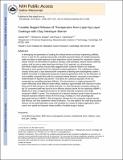Tunable staged release of therapeutics from layer-by-layer coatings with clay interlayer barrier
Author(s)
Min, Jouha; Braatz, Richard D.; Hammond, Paula T.
DownloadBraatz_Tunable staged.pdf (5.719Mb)
PUBLISHER_CC
Publisher with Creative Commons License
Creative Commons Attribution
Terms of use
Metadata
Show full item recordAbstract
In developing new generations of coatings for medical devices and tissue engineering scaffolds, there is a need for thin coatings that provide controlled sequential release of multiple therapeutics while providing a tunable approach to time dependence and the potential for sequential or staged release. Herein, we demonstrate the ability to develop a self-assembled, polymer-based conformal coating, built by using a water-based layer-by-layer (LbL) approach, as a dual-purpose biomimetic implant surface that provides staggered and/or sustained release of an antibiotic followed by active growth factor for orthopedic implant applications. This multilayered coating consists of two parts: a base osteoinductive component containing bone morphogenetic protein-2 (rhBMP-2) beneath an antibacterial component containing gentamicin (GS). For the fabrication of truly stratified composite films with the customized release behavior, we present a new strategy—implementation of laponite clay barriers—that allows for a physical separation of the two components by controlling interlayer diffusion. The clay barriers in a single-component GS system effectively block diffusion-based release, leading to approximately 50% reduction in bolus doses and 10-fold increase in the release timescale. In a dual-therapeutic composite coating, the top GS component itself was found to be an effective physical barrier for the underlying rhBMP-2, leading to an order of magnitude increase in the release timescale compared to the single-component rhBMP-2 system. The introduction of a laponite interlayer barrier further enhanced the temporal separation between release of the two drugs, resulting in a more physiologically appropriate dosing of rhBMP-2. Both therapeutics released from the composite coating retained their efficacy over their established release timeframes. This new platform for multi-drug localized delivery can be easily fabricated, tuned, and translated to a variety of implant applications where control over spatial and temporal release profiles of multiple drugs is desired.
Date issued
2013-12Department
Massachusetts Institute of Technology. Department of Chemical EngineeringJournal
Biomaterials
Publisher
Elsevier
Citation
Min, Jouha, Richard D. Braatz, and Paula T. Hammond. “Tunable Staged Release of Therapeutics from Layer-by-Layer Coatings with Clay Interlayer Barrier.” Biomaterials 35, no. 8 (March 2014): 2507–2517.
Version: Author's final manuscript
ISSN
01429612
1878-5905